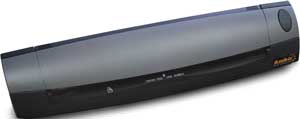GCN Lab Review | A scanner for all reasons


Connecting state and local government leaders
When we first received the tiny, 17-ounce DocketPort DS485-90 scanner from Ambir Technology, we were skeptical. We've seen small-scale scanners before,and the performance level claimed by this device'six pages per minute induplex mode at 600 dots per inch'seemed a bit much.

MIGHTY MITE: The DocketPort DS485-90 scanner is efficient and briefcase-friendly.
Still, we decided to give it a try'and
we were pleasantly surprised. Setting
up the DS485 was a breeze. It simply
plugs into a USB port on your desktop
or notebook PC and it's ready to go. Although
there is a port for one, you don't
have to hook up an external power supply
to operate the scanner. It can draw
enough power to operate through the
USB cable. Unlike other scanners we've
tested, this one needs no warm-up
time. It's ready to go as soon as you
plug it in, or after it's been sitting idle
for several hours.
There's an installation CD if you want
it, although it's not entirely necessary.
When you install the scanner's software,
however, you can access a calibration
program and several other advanced
features, such as the ability to launch a
scan by pressing a button on the DS485
and having your computer launch the
appropriate program. The CD also has a
full version of PaperPort 9 on it, which is
an organizational program that helps
improve the scanner's functionality.
When it came time for the
rubber to hit the road, the scanner
was up to the challenge. It
was not the fastest scanner
we've ever seen, but was a lot
quicker than we expected, considering
we were running it at
600 dpi and 24-bit color'and
that's while drawing power via
the USB port.
To initiate a scan, you simply
push the only button on the
front of the scanner. The entire
device is 12.5 inches long and 2
inches wide, so the button is
easy to find. Your computer
screen will then ask you if you
want to run the DocketSCAN
program, if you've installed it.
You can also use the standard
TWAIN control panel if you prefer. Once
you tell your computer what size paper
you're scanning (it defaults to standard 8.5-
by 11-inch office paper) you simply handfeed
the sheets through it.
The DS485 was able to scan
a document on standard
paper with all-black text at a
rate of 5.8 pages per minute
during testing. This was in
full-duplex mode, scanning
both sides at once, so you'll
see better performance with
single-sided documents.
The scanner was predictably
slower with full-color documents,
averaging 2.7 pages per
minute on a complex color
image printed on both sides of
a page.
Once you have the images
scanned, the PaperPort 9 software
really helps. At a glance,
you can see all the pages you've
scanned in a graphical format. These can
then be converted to Portable Document
Format. Using the newest version of Acrobat
reader, you can then cut and paste the
text into other formats, such as Word files.
This is a roundabout way to achieve optical
character recognition, but we found
that accuracy rates were close to 100 percent
using standard documents.
Because the unit doesn't need a separate
power cord, the DS485 is a good
travel companion. It simply slides in beside
a laptop in most computer bags.
And it ships with a faux leather sleeve to
protect it during trips. It also has an optional
plastic riser in case you want to
make the DS485 a fixture on your desk.
The riser makes it easier to feed documents,
but in general we found the scanner
easy to use without the extra help.
But as with anything in technology,
miniature means more expensive. In this
case, the DS485's $390 price tag will likely
rule out all but the most mobile professionals
(specifically, those with on-the-road
scanning needs). You can get a far faster,
higher-resolution Hewlett-Packard flatbed
scanner, for instance, for under $300.
If you're looking for a speedy scanner
that's briefcase-friendly, the DS485 is a
perfect choice. Consider it for field personnel
and other specialized users.
NEXT STORY: GCN Lab Review | Tape drives, meet disks




